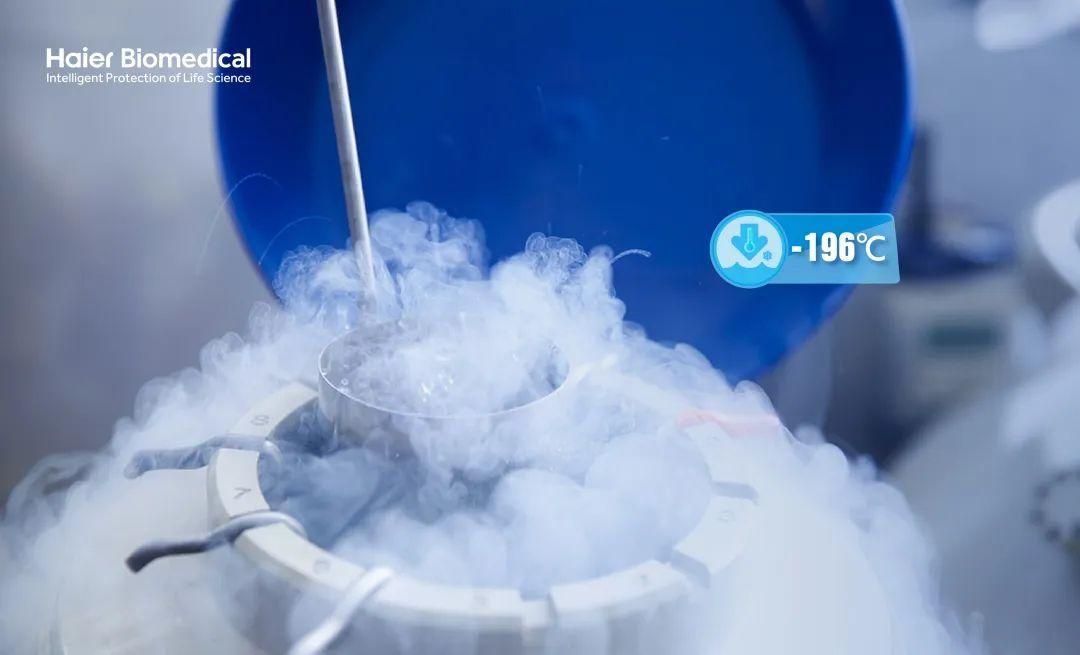Liquid nitrogen (LN2) plays a vital role in the world of assisted reproductive technology, as the go-to cryogenic agent for storing precious biological materials, such as eggs, sperm, and embryos. Offering extremely low temperatures and the ability to maintain cellular integrity, LN2 ensures the long-term preservation of these delicate specimens. However, handling LN2 poses unique challenges, due to its extremely cold temperature, rapid expansion rate and the potential risks associated with oxygen displacement. Join us as we delve into the essential safety measures and best practices necessary to maintain a secure and efficient cryo preservation environment, safeguarding staff, and the future of fertility treatments.

Haier Biomedical Liquid Nitrogen Storage Solution
Minimising Risks in the Operation of a Cryogenic Room
There are various risks associated with the handling of LN2, including explosion, asphyxiation, and cryogenic burns. Since the volume expansion ratio of LN2 is about 1:700 – meaning that 1 litre of LN2 will vaporise to produce about 700 litres of nitrogen gas – great care needs to be taken when handling glass vials; a nitrogen bubble could shatter the glass, creating shards capable of causing injury. Additionally, LN2 has a vapor density of about 0.97, meaning it is less dense than air and will pool at ground level when the temperature is very low. This accumulation poses an asphyxiation hazard in confined spaces, depleting the oxygen level in the air. Asphyxiation hazards are further compounded by the rapid release of LN2 to create vapor fog clouds. Exposure to this intensely cold vapour, particularly on the skin or in the eyes – even briefly – can lead to cold burns, frostbite, tissue damage or even permanent eye damage.
Best Practices
Every fertility clinic should carry out an internal risk assessment regarding the operation of its cryogenic room. Advice on how to carry out these assessments can be obtained in the Codes of Practice (CP) publications from the British Compressed Gases Association.1 In particular, CP36 is useful to advise on the storage of cryogenic gases onsite, and CP45 gives guidance on the design of a cryogenic storage room.[2,3]

NO.1 Layout
A cryogenic room’s ideal location is one that offers the greatest accessibility. Careful consideration of the placement of the LN2 storage container is required, as it will require filling via a pressurised vessel. Ideally, the liquid nitrogen supply vessel should be located outside of the sample storage room, in an area that is well ventilated and secure. For larger storage solutions, the supply vessel is often connected directly to the storage vessel via a cryogenic transfer hose. If the layout of the building does not allow the supply vessel to be located externally, extra care must be taken during handling of the liquid nitrogen, and a detailed risk assessment needs to be carried out, encompassing monitoring and extraction systems.
NO.2 Ventilation
All cryogenic rooms must be well ventilated, with extraction systems to prevent nitrogen gas build-up and protect against oxygen depletion, minimising the risk of asphyxiation. Such a system needs to be suitable for a cryogenically cold gas, and linked to an oxygen depletion monitoring system to detect when the oxygen level drops below 19.5 per cent, in which case it will initiate an increase in the air exchange rate. Extract ducts should be located at ground level while depletion sensors must be placed approximately 1 meter above the floor level. However, exact positioning should be decided after a detailed site survey, as factors such as room size and layout will affect the optimal placement. An external alarm should also be installed outside of the room, providing both audio and visual warnings to signify when it is unsafe to enter.

NO.3 Personal Safety
Some clinics may also choose to equip employees with personal oxygen monitors and employ a buddy system whereby people will only ever enter the cryogenic room in pairs, minimizing the amount of time a single person is in the room at any one time. It is the responsibility of the company to train employees on the cold storage system and its equipment and many choose to have employees undertake online nitrogen safety courses. Staff should wear the appropriate personal protective equipment (PPE) to safeguard against cryogenic burns, including eye protection, gloves/gauntlets, suitable footwear, and a lab coat. It is essential for all staff to undergo firstaid training on how to deal with cryogenic burns, and it is ideal to have a supply of lukewarm water close by to rinse off the skin if a burn has occurred.
NO.4 Maintenance
A pressurized vessel and LN2 container have no moving parts, meaning that a basic annual maintenance schedule is all that is required. Within this, the condition of the cryogenic hose should be checked, as well as any necessary replacements of safety release valves. Staff should continuously check that there are no areas of frosting – either on the container or on the feeder vessel – which could indicate an issue with the vacuum. With careful consideration of all these factors, and a regular maintenance schedule, pressurizedvessels can last for up to 20 years.
Conclusion
Ensuring the safety of a fertility clinic’s cryo preservation room where LN2 is used is of utmost importance. While this blog has outlined various safety considerations, it is essential for each clinic to conduct its own internal risk assessment to address specific requirements and potential hazards. Partnering with expert providers in cold storage containers, such as Haier Biomedical, is crucial to meet cryostorage needs effectively and safely. By prioritizing safety, adhering to best practices, and collaborating with trusted professionals, fertility clinics can maintain a secure cryo preservation environment, safeguarding both staff and the viability of precious reproductive materials.
References
1.Codes of Practice - BCGA. Accessed May 18, 2023. https://bcga.co.uk/pubcat/codes-of-practice/
2.Code of Practice 45: Biomedical cryogenic storage systems. Design and operation. British Compressed Gases Association. Published online 2021. Accessed May 18, 2023. https://bcga.co.uk/wp-
3.content/uploads/2021/11/BCGA-CP-45-Original-05-11-2021.pdf
4.Code of Practice 36: Cryogenic liquid storage at users’ premises. British Compressed Gases Association. Published online 2013. Accessed May 18, 2023. https://bcga.co.uk/wp-content/uploads/2021/09/CP36.pdf
Post time: Feb-01-2024











